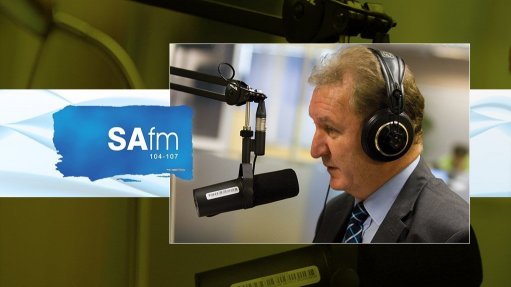
Creamer Media on SAfm.
Photo by: Creamer Media
Every Friday, SAfm’s radio anchor Sakina Kamwendo speaks to Martin Creamer, publishing editor of Engineering News & Mining Weekly. Reported here is this Friday’s At the Coalface transcript:
Kamwendo: South Africa’s high-quality iron-ore is playing a key role in the world’s move to clean steel.
Creamer: This is Kumba Iron Ore, and it’s lumpy, and the world is moving very fast towards green steel, and right at the forefront is Kumba, with Anglo American. Anglo has now signed four agreements, two with German steel companies, one with a Japanese steel company, and the latest H2 Green Steel, of Sweden. H2 Green Steel will probably be the first to do this because they don’t produce yet and they will go straight into the production of green steel, using our South African iron-ore.
Kamwendo: Transport in mines has become a burning issue since the introduction of new regulations for trackless mining.
Creamer: Fall-of-ground was the big thing. The mines concentrated on fall-of-ground, which was killing a lot of people. In 2007, it killed 76 people. The mines then brought that down last year to six people, and then all of a sudden, another big problem hit the mines, and that is trackless mining, the trackless mobile machines. These killed 17 people last year and 16 the year before, so now the big focus is on trackless. The government had no option but to bring in new regulations. They did it at Christmas and now the industry is scratching around to make sure they can get collision-avoidance systems and also pedestrian-avoidance systems because these trackless vehicles are hitting into people walking around in the mines and 17 death has shocked the industry.
Kamwendo: Steps are being taken to replace smelting, which uses a huge volume of South Africa’s scarce electricity.
Creamer: It is so important to get away from smelting. There are other ways of doing things. South Africa uses smelting across the board in the mining industry. Once you mine the ore, you smelt it. But it takes up an enormous amount of electricity and now all eyes are on Sedibelo in North West because it has moved away from smelting. It will use on 19% or our precious electricity compared with what is used for smelting by going the hydrometallurgical route. Hope are rising that once the Kell system is proven, and it should be soon, all the other smelters will follow this and stop squandering our electricity.
Kamwendo: Thanks so much. Martin Creamer is publishing editor of Engineering News & Mining Weekly, and he’ll be back at the same time next Friday for another edition of At The Coalface.